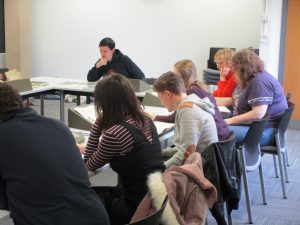The University of Exeter is blessed with many unique archival resources that we integrate into our teaching: Victorian periodicals, writers’ papers, collections of historical documents, and over the course of the term I’ll say a bit about them all. Today I am going to spotlight the treasure trove of popular culture history that is the Bill Douglas Cinema Museum, which never ceases to inspire us and our students!
The BDCM contains the sorts of items you would expect in a museum devoted to the cinema: old filmmaking equipment, ephemera (e.g. postcards, cigarette cards, toys) relating to major movie stars such as Charlie Chaplin and Marilyn Monroe, posters and programmes for film showings, original cel artwork from Disney films, fan magazines, and documents that used to belong to filmmakers (the Lumière brothers, for instance).
But the BDCM also covers hundreds of years of the moving image! So it has significant collections of panorama, magic lantern slides, stereoscopes, kaleidoscopes, and peep shows. These are an invaluable resource for students who are reading eighteenth- and nineteenth-century literature: we can see for ourselves the objects and experiences being described by novelists and poets. These materials also provide a rich insight into the history of popular visual culture, running right up to the era of the cinema!
Myself and my colleague Dr Sinéad Moynihan were doing some teaching in the BDCM recently. This was on an MA module called The Literature of Cold War America and the particular topic that week was the blacklist and the anti-communist witch-hunts of mid-century America. We covered a lot of different texts in the seminar, such as the BDCM’s collection of 1950s books and pamphlets that investigated whether or not the film industry really had been infiltrated by communist subversives.
We started by thinking about the African-American performers, writers, and political activists under FBI surveillance during the 1950s. To this end, we looked at the material from the BDCM relating to Paul Robeson, the singer prevented from leaving the country in 1950; later that year he started a political newspaper entitled Freedom. One item in the BDCM collection is the souvenir programme for Robeson’s 1958 UK tour – which he undertook as soon as his passport was restored. The students also read short stories by the writer Alice Childress and thought about their different publication contexts (e.g. how the stories published in Freedom in 1951 compared to their republication in The Baltimore Afro-American in 1956).

Here are the students looking at film fan magazines, lobby cards, movie posters, and postcards relating to Marlon Brando, star of the 1954 film On the Waterfront. We discussed what Brando’s celebrity and acting style might say about the United States in the 1950s, torn between swaggering confidence and deep-seated anxiety.
The BDCM offers students the opportunity to volunteer and gain experience of working in the museum sector and modules such as British Screens have curatorial activities built into them. You can see the display cases that students have put together as soon as you enter! If you’re visiting Exeter in the coming months, the BDCM is definitely worth checking out, and you can see the student-curated displays for yourself!